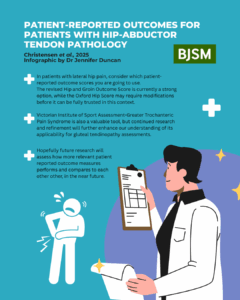Introduction
Lateral hip pain, particularly from hip-abductor tendon pathology (HATP), is a growing concern in both clinical practice and research. However, are the patient-reported outcome measures (PROMs) we rely on truly valid for this population? In our latest study published in the British Journal of Sports Medicine, we investigated the psychometric validity of the Copenhagen Hip and Groin Outcome Score (HAGOS) and the Oxford Hip Score (OHS) in patients with HATP (1).
Key Findings
We analyzed responses from 210 patients (predominantly women, median age 56) using confirmatory factor analysis (CFA) and item response theory. Our findings highlighted the following:
- The original versions of HAGOS and OHS did not demonstrate psychometric validity in patients with HATP.
- A revised scoring format for HAGOS showed good validity and is a more appropriate tool for this population.
- The OHS needs slight modifications before it can be reliably used for assessing HATP.
How does this relate to core-outcome PROMS for patients with Hip-abductor tendon pathology
In a recent Letter to the Editor (2), we discussed the International Scientific Tendinopathy Symposium Consensus (ICON) 2020 statement and its recommendation of the Victorian Institute of Sport Assessment-Greater Trochanteric Pain Syndrome (VISA-G) questionnaire as an interim core outcome measure for gluteal tendinopathy and the VISA-G is now being increasingly referred to as a core PROM outcome for gluteal tendinopathy in recent literature. (3,4) While the VISA-G is certainly a widely recognized tool, (3,4) we believe there is still room for further research to ensure it fully captures the patient experience. The ICON group argues that while the VISA-G is not perfect, it remains the most viable choice at present, and ongoing work is needed to develop an optimal PROM for assessing disability in gluteal tendinopathy. The ICON group kindly responded to our concerns, acknowledging the limitations of the VISA-G while explaining their rationale for recommending it. They emphasized that:
- No existing outcome measure had sufficient clinimetric properties to be included in a Core Outcome Set, but VISA-G had the best available, albeit low, evidence for content validity.
- The recommendation for interim use of VISA-G was made following COSMIN guidelines, considering the absence of a superior alternative and the need for a measure clinicians and researchers can use now.
- The lack of unidimensionality in VISA-G needs to be addressed, and future research is necessary to improve PROMs for gluteal tendinopathy.
We appreciate this response and support ongoing efforts to refine and validate PROMs in this field. Both our research and the ICON consensus emphasize the importance of continued efforts to enhance PROMs in this field to ensure it serves patients and clinicians in the best possible way.
Why Does This Matter?
HATP, which includes gluteal tendinopathy and tendon tears, is a major cause of lateral hip pain, particularly in middle-aged women. Symptoms often impact sleep, walking, and participation in physical activity. Having a valid PROM is essential to accurately track patient progress and guide treatment decisions. Our study emphasizes the need for PROMs that capture the unique challenges of HATP patients, such as pain during movement and night pain.
What’s Next?
The revised HAGOS provides an option for assessing patients with HATP and can help clinicians better understand their patients’ impairments, activity and participation restrictions. Future research should focus on refining OHS to ensure it accurately reflects the experiences of those with lateral hip pain. Additionally, we support further validation efforts for VISA-G and other PROMs to ensure the best available tools are being used for these patients.
Takeaway for Clinicians
If you are treating patients with lateral hip pain, consider carefully which patient-reported outcome scores you are going to use. The revised HAGOS is currently a strong option, while the OHS may require modifications before it can be fully trusted in this context. Additionally, while the VISA-G is also a valuable tool, and is increasingly referred to as a core PROM outcome, continued research and refinement will further enhance our understanding of its applicability for gluteal tendinopathy assessments. Hopefully future research will assess how more relevant PROMS performs and compares to each other, in the near future.

Further Reading
For access to the revised HAGOS scoring format, visit Hvidovre Hospital’s website.
References:
- Christensen KB, Thorborg K, Kierkegaard-Brøchner S, et al. Psychometric validation of the Copenhagen Hip and Groin Outcome Score (HAGOS) and Oxford Hip Score (OHS) in patients with hip-abductor tendon pathology. Br J Sports Med. 2025;0:1–8. doi:10.1136/bjsports-2024-108446.
- Thorborg K, Christensen KB, Kierkegaard-Brøchner S, Lange J, Bohn MB. Letter to Editor: Patient-reported outcome measures for gluteal tendinopathy – more empirical evidence is needed? Br J Sports Med. Published 8 April 2024.
- Fearon AM, Grimaldi A, Mellor R, Nasser AM, Fitzpatrick J, Ladurner A, et al. ICON 2020—International Scientific Tendinopathy Symposium Consensus: the development of a core outcome set for gluteal tendinopathy. Br J Sports Med. 2024;58(5):245–254. doi:10.1136/bjsports-2023-107150.
- Nasser A, Grimaldi A. Clinimetrics: The Victorian Institute of Sport Questionnaire – gluteal tendinopathy (VISA-G). J Physiother. 2024 Apr;70(2):153. doi: 10.1016/j.jphys.2024.02.009. Epub 2024 Mar 6. PMID: 38453585.
Authors:
Karl Bang Christensen,1 Kristian Thorborg, 2 Signe Kierkegaard Brøchner 3,4
Mathias Høgsholt,5 Jeppe Lange,6,7 Marie Bager Bohn7,8
(1) Section of Biostatistics, Department of Public Health, University of Copenhagen,
Kobenhavn, Region Hovedstaden, Denmark
(2) Sports Orthopedic Research Center – Copenhagen (SORC-C), Department of
Orthopedic Surgery, Amager-Hvidovre Hospital, Copenhagen University Hospital,
Kobenhavn, Denmark
(3) Orthopaedic Surgery and Physio and Occupational Therapy, Regionshospitalet
Horsens, Horsens, Denmark
(4) Clinical Medicine, Aarhus Universitet, Aarhus, Denmark
(5) Department of Occupational and Physical Therapy, Regionshospitalet Horsens,
Horsens, Midtjylland, Denmark
(6) HHip, Department of Orthopedics and Physio and Occupational Therapy, Horsens
Regional Hospital, Horsens, Regionshospitalet Horsens, Horsens, Midtjylland,
Denmark
(7) Department of Clinical Medicine, Aarhus University Department of Clinical Medicine,
Aarhus, Midtjylland, Denmark
(8) HHip, Regionshospitalet Horsens, Horsens, Midtjylland, Denmark
KBC and KT are joint first authors.